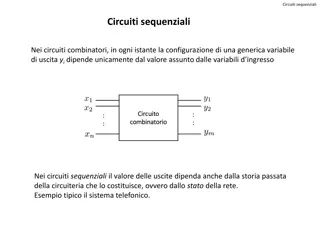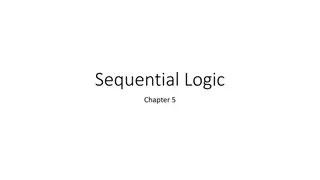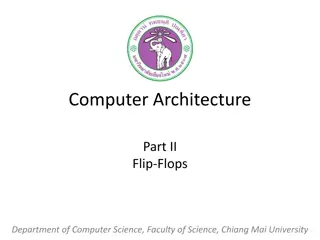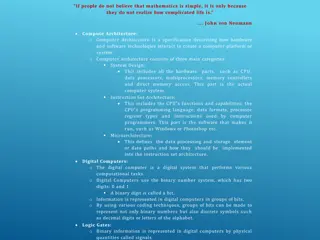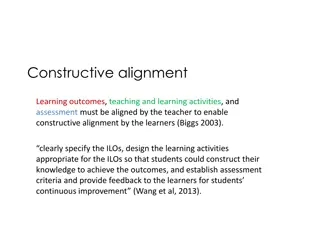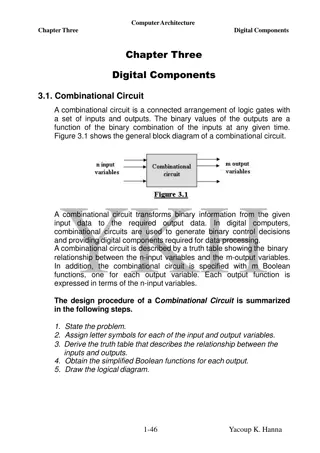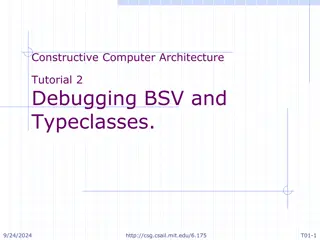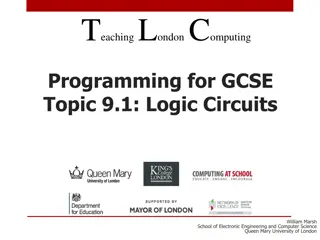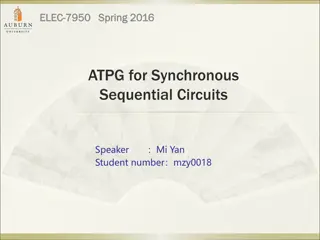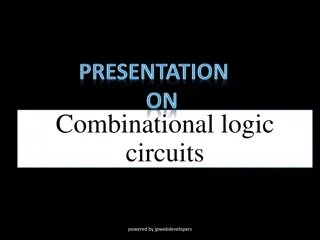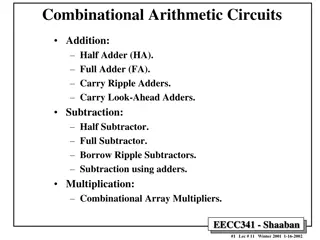Constructive Computer Architecture: Folded Combinational Circuits
Unveil the intricacies of implementing loop computations and large combinational circuits through folding techniques. Explore the innovative design alternatives and packaging solutions for latency-insensitive modules and rule execution in BSV.
Download Presentation

Please find below an Image/Link to download the presentation.
The content on the website is provided AS IS for your information and personal use only. It may not be sold, licensed, or shared on other websites without obtaining consent from the author.If you encounter any issues during the download, it is possible that the publisher has removed the file from their server.
You are allowed to download the files provided on this website for personal or commercial use, subject to the condition that they are used lawfully. All files are the property of their respective owners.
The content on the website is provided AS IS for your information and personal use only. It may not be sold, licensed, or shared on other websites without obtaining consent from the author.
E N D
Presentation Transcript
Constructive Computer Architecture Folded Combinational circuits Arvind Computer Science & Artificial Intelligence Lab. Massachusetts Institute of Technology September 25, 2017 http://csg.csail.mit.edu/6.175 L08-1
Design Alternatives Combinational (C) f1 f2 f3 Pipeline (P) f1 f2 f3 Folded (F) Reuse a block, multicycle fi Clock? Clock: C < P F Area? Area: F < C < P Throughput? Throughput: F < C < P L08-2 http://csg.csail.mit.edu/6.175 September 25, 2017
Content How to implement loop computations? Need registers to hold the state from one iteration to the next Request-Response Latency-Insensitive modules A common way to implement large combinational circuits is by folding or as loops Multiplication Polymorphic Multiply L08-3 http://csg.csail.mit.edu/6.175 September 25, 2017
Expressing a loop using registers Such a loop cannot be implemented by unfolding because the number of iterations is input- data dependent A register is needed to hold s from one iteration to the next s has to be initialized when the computation starts, and updated every cycle until the computation terminates int s = s0; while (p(s)) { s = f(s); } return s; C-code s0 f p sel sel = start en = start | notDone notDone s en L08-4 http://csg.csail.mit.edu/6.175 September 25, 2017
Expressing a loop in BSV When a rule executes: the register s is read at the beginning of a clock cycle computations to evaluate the next value of the register and the sen are performed If sen is True then s is updated at the end of the clock cycle A mux is needed to initialize the register Reg#(t) s <- mkRegU(); rule step; if (p(s)) begin s <= f(s); end endrule s0 f p sel notDone How should this circuit be packaged for proper use? s en sel = start en = start | notDone L08-5 http://csg.csail.mit.edu/6.175 September 25, 2017
Packaging a computation as a Latency-Insensitive Module getResultF startF F en en ready busy Interface with guards interface F#(t); method Action start (t a); method ActionValue#(t) getResult; endinterface L08-6 http://csg.csail.mit.edu/6.175 September 25, 2017
Request-Response Module module mkF (F#(t)); Reg#(t) s <-mkRegU(); Reg#(Bool) busy <- mkReg(False); rule step; if (p(s)) begin s <= f(s); end endrule method Action start(t a) if (!busy); s <= a; busy <= True; endmethod methodActionValue t getResult if (!p(s)&& busy); busy <= False; return s; endmethod endmodule http://csg.csail.mit.edu/6.175 L08-7 September 25, 2017
Using F getResult get result invoke F start F inQ outQ F#(t) f <- mkF( ) This system is insensitive to the latency of F rule invokeF; f.start(inQ.first); inQ.deq; endrule rule getResult; let x <- f.getResult; outQ.enq(x); endrule A rule can be executed only if guards of all of its actions are true September 25, 2017 L08-8 http://csg.csail.mit.edu/6.175
Combinational 32-bit multiply function Bit#(64) mul32(Bit#(32) a, Bit#(32) b); Bit#(32) tp = 0; Bit#(32) prod = 0; for(Integer i = 0; i < 32; i = i+1) begin Bit#(32) m = (a[i]==0)? 0 : b; Bit#(33) sum = add32(m,tp,0); prod[i] = sum[0]; tp = sum[32:1]; end return {tp,prod}; endfunction Combinational circuit uses 31 add32 circuits We can reuse the same add32 circuit if we store the partial results in a register L08-9 http://csg.csail.mit.edu/6.175 September 25, 2017
Multiply using registers function Bit#(64) mul32(Bit#(32) a, Bit#(32) b); Bit#(32) prod = 0; Bit#(32) tp = 0; for(Integer i = 0; i < 32; i = i+1) begin Bit#(32) m = (a[i]==0)? 0 : b; Bit#(33) sum = add32(m,tp,0); prod[i:i] = sum[0]; tp = sum[32:1]; end return {tp,prod}; endfunction Need registers to hold a, b, tp, prod and i Combinational version Update the registers every cycle until we are done L08-10 http://csg.csail.mit.edu/6.175 September 25, 2017
Sequential Circuit for Multiply Reg#(Bit#(32)) a <- mkRegU(); Reg#(Bit#(32)) b <- mkRegU(); Reg#(Bit#(32)) prod <-mkRegU(); Reg#(Bit#(32)) tp <- mkReg(0); Reg#(Bit#(6)) i <- mkReg(32); state elements rule mulStep; if (i < 32) begin Bit#(32) m = (a[i]==0)? 0 : b; Bit#(33) sum = add32(m,tp,0); prod[i] <= sum[0]; tp <= sum[32:1]; i <= i+1; end endrule similar to the loop body in the combinational version September 25, 2017 a rule to describe the dynamic behavior So that the rule has no effect until i is set to some other value L08-11 http://csg.csail.mit.edu/6.175
Dynamic selection requires a mux i when the selection indices are regular then it is better to use a shift operator (no gates!) a[i] a >> a a[0],a[1],a[2], 0 L08-12 http://csg.csail.mit.edu/6.175 September 25, 2017
Replacing repeated selections by shifts rule mulStep if (i < 32); Bit#(32) m = (a[0]==0)? 0 : b; a <= a >> 1; Bit#(33) sum = add32(m,tp,0); prod <= {sum[0], prod[31:1]}; tp <= sum[32:1]; i <= i+1; endrule L08-13 http://csg.csail.mit.edu/6.175 September 25, 2017
Circuit for Sequential Multiply bIn aIn s1 0 b 0 0 << s1 +1 add << s1 s1 0 32:1 31 [30:0] a prod tp i s2 s2 s2 s2 31:0 0 == 32 done result (high) result (low) s1 = start_en s2 = start_en | !done L08-14 http://csg.csail.mit.edu/6.175 September 25, 2017
Circuit analysis Number of add32 circuits has been reduced from 31 to one, though some registers and muxes have been added The longest combinational path has been reduced from 62 FAs to one add32 plus a few muxes The sequential circuit will take 31 clock cycles to compute an answer L08-15 http://csg.csail.mit.edu/6.175 September 25, 2017
Packaging Multiply as a Latency-Insensitive Module 32 getMulResult 64 startMul 32 Multiply en en ready busy Interface with guards interface Multiply; method Action startMul (Bit#(32) a, Bit#(32) b); method ActionValue#(Bit#(64)) getResultMul; endinterface L08-16 http://csg.csail.mit.edu/6.175 September 25, 2017
Multiply Module Module mkMultiply (Multiply); Reg#(Bit#(32)) a<-mkRegU(); Reg#(Bit#(32)) b<-mkRegU(); Reg#(Bit#(32)) prod <-mkRegU(); Reg#(Bit#(32)) tp <- mkReg(0); Reg#(Bit#(6)) i <- mkReg(32); Reg#(Bool) busy <- mkReg(False); rule mulStep if (i < 32); Bit#(32) m = (a[0]==0)? 0 : b; a <= a >> 1; Bit#(33) sum = add32(m,tp,0); prod <= {sum[0], prod[31:1]}; tp <= sum[32:1]; i <= i+1; endrule method Action startMul(Bit#(32) x, Bit#(32) y) if (!busy); a <= x; b <= y; busy <= True; i <= 0; endmethod methodActionValue Bit#(64) getMulRes if ((i==32) && busy); busy <= False; return {tp,prod}; endmethod L08-17 http://csg.csail.mit.edu/6.175 September 25, 2017
Circuit for Sequential Multiply bIn aIn a b startMul s1 0 b en rdy 0 0 << s1 +1 add << s1 s1 0 32:1 31 [30:0] a prod tp i s2 getMulRes s2 s2 s2 31:0 0 == 32 result (high) result (low) en rdy done s1 = start_en s2 = start_en | !done busy L08-18 http://csg.csail.mit.edu/6.175 September 25, 2017
Polymorphic Multiply Module t Tmul#(t,2) 32 getMulResult 64 startMul 32 Multiply en en ready busy Polymorphic Interface t interface Multiply#(32); method Action startMul (Bit#(32) a, Bit#(32) b); method ActionValue#(Bit#(64)) getResultMul; endinterface Tmul#(t,2) t t L08-19 http://csg.csail.mit.edu/6.175 September 25, 2017
Polymorphic Multiply Module mkMultiply (Multiply#(t)); Reg#(Bit#(t)) a<-mkRegU(); Reg#(Bit#(t)) b<-mkRegU(); Reg#(Bit#(t)) prod <-mkRegU(); Reg#(Bit#(t)) tp <- mkReg(0); vt = valueOf(t); Reg#(Bit#(TAdd#(1, TLog#(t)))) i <- mkReg(vt); Reg#(Bool) busy <- mkReg(False); rule mulStep if (i < vt); Bit#(t) m = (a[0]==0)? 0 : b; a <= a >> 1; Bit#(Tadd#(t)) sum = addN(m,tp,0); prod <= {sum[0], prod[(vt-1):1]}; tp <= sum[vt:1]; i <= i+1; endrule method Action startMul(Bit#(t) x, Bit#(t) y) if (!busy); a <= x; b <= y; busy <= True; i<=0; endmethod methodActionValue#(Bit#(TMul#(t,2)) getMulRes if busy <= False; return {tp,prod}; endmethod http://csg.csail.mit.edu/6.175 ((i==vt)&& busy); L08-20 September 25, 2017



